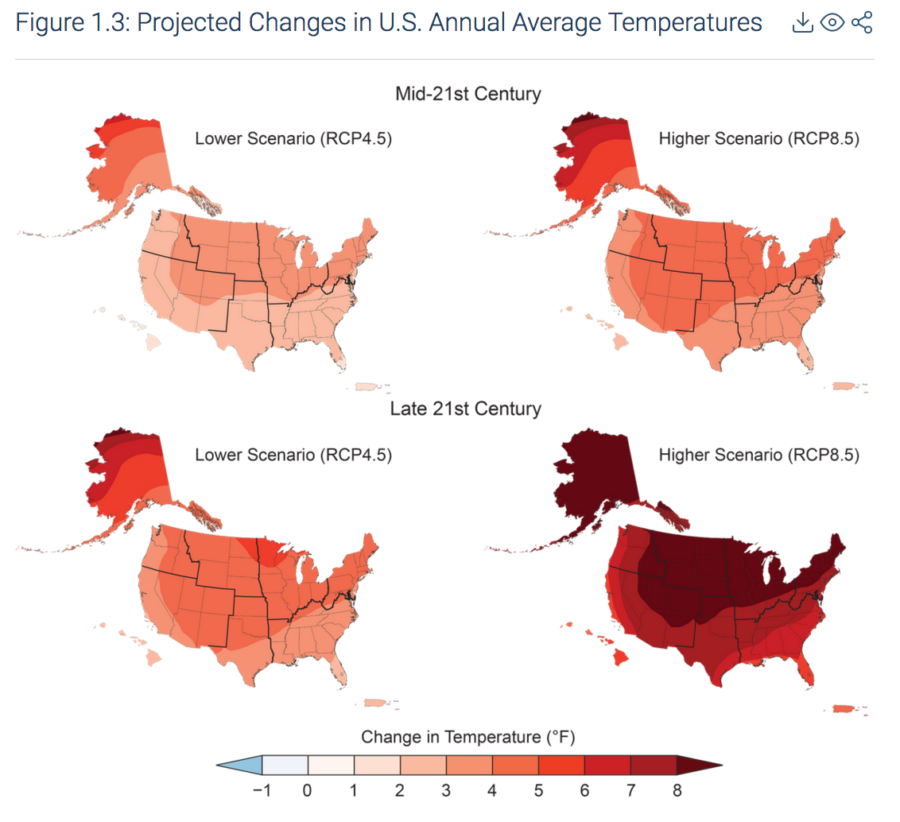New climate report projects major economic damage to U.S.
A recent report by the NOAA shows large increases in temperatures are possible by 2090.
November 27, 2018
While much of America stormed retail stores for Black Friday deals, the National Oceanic and Atmospheric Administration (NOAA) released its Fourth National Climate Assessment on Nov. 23, detailing climate change and its impact on the United States.
The report focused on already-apparent effects of climate change alongside the expected impact on everything from the U.S. economy to national health. Another section covered actions that must be taken to reduce the risks associated with climate change, although it stated that an “immediate and substantial” shift would need to occur to avoid its worst consequences.
The report projected significant increases in global temperatures, sea levels, rates of natural disasters and the severity of climate events between now and 2090.
One of the core criticisms of climate change regulation is its financial impact on affected industries. NOAA’s assessment, however, argues that the economic damages caused by climate change could dwarf losses caused by increased regulations.
“The continued warming that is projected to occur… is expected to cause substantial net damage to the U.S. economy throughout this century, especially in the absence of increased adaptation efforts,” according to the report. “With continued growth in emissions at historic rates, annual losses in some economic sectors are projected to reach hundreds of billions of dollars by the end of the century.”
In addition to direct impacts on industry, the climate assessment projected declining water availability and quality caused by droughts, flooding and saltwater contamination. NOAA said that forward-thinking water management strategies could help to reduce future risks, although they noted that their real-world implementation is rare.
Water issues were linked to the anticipated decay of national health, which the report said would also be impacted by several other factors. According to NOAA, climate change is projected to increase the frequency and severity of allergic reactions as well as the generally increased spread of disease.
“Rising air and water temperatures and more intense extreme events are expected to increase exposure to waterborne and foodborne diseases, affecting food and water safety,” according to the climate assessment. “Climate change is also projected to alter the geographic range and distribution of disease-carrying insects and pests, exposing more people to ticks that carry Lyme disease and mosquitoes that transmit viruses such as Zika, West Nile, and dengue, with varying impacts across regions.”
The national climate change assessment analyzed impacts across the nation, stating that the projected damages to local economies and infrastructure across the nation will have a disproportionate effect on lower-income and marginalized communities in the United States.
This is largely due to the fact that wealthier communities have a greater capacity to prepare for and cope with damage caused by climate change, whereas already disadvantaged groups would not have the resources to recover from damage to their infrastructure.
Indigenous people were specifically highlighted as groups that would be disproportionately impacted due to many industries negatively impacted by climate change including tourism and fishing.
“Throughout the United States, climate-related impacts are causing some Indigenous peoples to consider or actively pursue community relocation as an adaptation strategy,” according to the report. “The impacts of climate change… are expected to increasingly disrupt Indigenous peoples’ livelihoods and economies, including agriculture and agroforestry, fishing, recreation, and tourism. Adverse impacts on subsistence activities have already been observed.”
NOAA’s assessment echoes several other climate reports released earlier in the year, albeit with a perspective primarily focused on the United States. The report can be read online through the U.S. Global Change Research Program’s website, http://globalchange.gov.
















